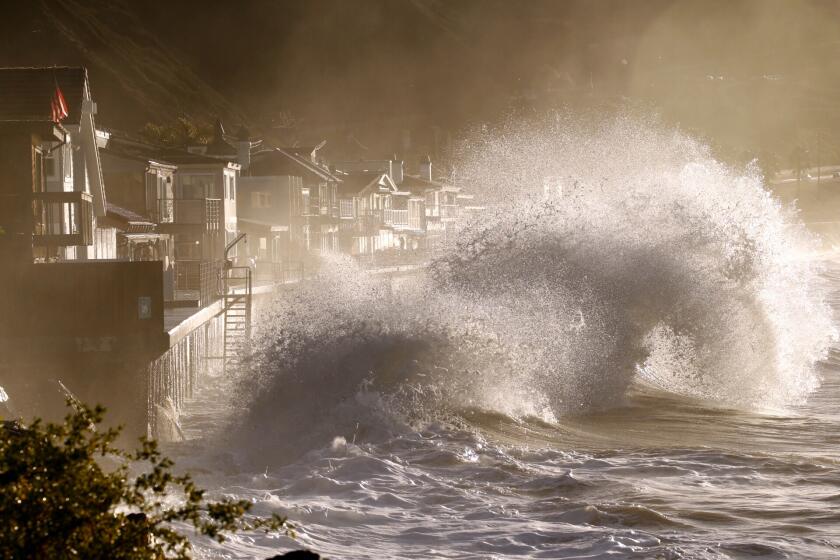
- Share via
The planet has experienced an astounding six-month run of record-breaking temperatures, including the hottest November on record, federal officials announced Thursday.
Global average temperatures last month were 2.59 degrees Fahrenheit above the 20th century average — 0.68 degrees above the previous record from November 2015, according to the National Oceanic and Atmospheric Administration, whose records date back to 1850.
The planet also experienced its hottest autumn on record — September through November — and its hottest ever January through November.
“It is virtually certain, with one month remaining in the year, that 2023 will be the warmest year on record,” said Karin Gleason, monitoring section chief with the agency’s National Centers for Environmental Information.
Aggressive and impactful reporting on climate change, the environment, health and science.
Last month saw record-breaking temperatures on land and in the oceans, Gleason said. South America, Africa and Asia each had their warmest November on record, while North America saw its second-warmest November on record.
In the contiguous United States, the average temperature in November was 44 degrees, or 2.7 degrees above the average, marking the 19th warmest November on record, she said.
The warming is largely driven by a strengthening El Niño, the tropical Pacific climate pattern associated with hotter global temperatures. Its counterpart, La Niña, is associated with cooler temperatures and had been in place previously for several years.
The hotter climate pattern is enhancing the effects of human-caused global warming, experts say.
“The overall trajectory, or trend, is warming, and then you have these influences of which [El Niño] is a primary player,” Gleason said. “The strong El Niño kind of broke through the barrier, and we’re starting to see temperature anomalies that we really haven’t seen historically in the record.”
Negotiators at United Nations climate talks in Dubai hammered out an agreement that the world must transition away from planet-warming fossil fuels.
The news comes only weeks after world leaders gathered in Dubai for COP28, an annual United Nations climate conference, during which nearly 200 countries agreed for the first time to move away from planet-warming fossil fuels.
Officials stressed that transitioning away from such fuels is critical to preventing additional planetary warming.
“As long as greenhouse gas concentrations keep rising, we can’t expect different outcomes from those seen this year,” read a statement from Carlo Buontempo, director of the Copernicus Climate Change Service in Europe, which has also affirmed that this was the hottest November on record. “The temperature will keep rising and so will the impacts of heatwaves and droughts. Reaching net zero as soon as possible is an effective way to manage our climate risks.”
NOAA has warned of a ‘historically strong’ El Niño through January, but so far, California’s wet season has been notably dry.
NOAA officials said the effects of this warming are already being felt around the globe. The first 11 months of 2023 rank the highest for the number of billion-dollar climate and weather disasters in the U.S., Gleason said.
So far, there have been 25 billion-dollar disasters this year — 5 more than the previous record set in 2020. They include devastating flooding in California from January through March; flooding in the Northeast in July and Hurricane Idalia in Florida in August.
The total cost of 2023 events now exceeds $81 billion, and they have resulted in at least 482 direct and indirect fatalities, Gleason said.
Warmer ocean temperatures have also contributed to an above-normal hurricane season, with 20 named storms in the Atlantic and 17 named storms in the eastern Pacific this year, according to Matt Rosencrans, a meteorologist with the NOAA Climate Prediction Center.
That includes August’s Hurricane Hilary, which brought the first issuance of tropical storm watches and warnings in California. Ocean temperatures in November were a record-breaking 1.8 degrees above normal for the month.
A winter storm system is bringing rain to Southern California, but it should pass through by Christmas Eve, making for a sunny holiday.
El Niño isn’t only associated with warmer global temperatures. The pattern is also associated with wetter conditions in California, and the storms coming into the state now are likely related to it, Rosencrans said.
“Going forward, the forecast is that El Niño is expected to continue through this Northern Hemisphere winter — with a robust El Niño, potentially of historical strength,” he said. There is a 54% chance of a historically strong El Niño during the November through January season.
The impacts of that could include an enhanced southern storm track, which may affect Southern California as well as the Gulf region and the Southwest U.S., Rosencrans said. Long-term forecasts favor above-normal precipitation and above-normal temperatures in California in January, Februrary and March.
However, the conditions this year have had at least one benefit for the Golden State, which was declared drought-free in November for the first time since 2020.
But the overall trends remain concerning, said Petteri Taalas, secretary general of the World Meteorological Organization, which also declared record warmth this year.
“We cannot return to the climate of the 20th century, but we must act now to limit the risks of an increasingly inhospitable climate in this and the coming centuries,” Taalas wrote in an update at the end of November.
“Greenhouse gas levels are record high. Global temperatures are record high. Sea level rise is record high. Antarctic sea ice is record low,” he said. “It’s a deafening cacophony of broken records.”











